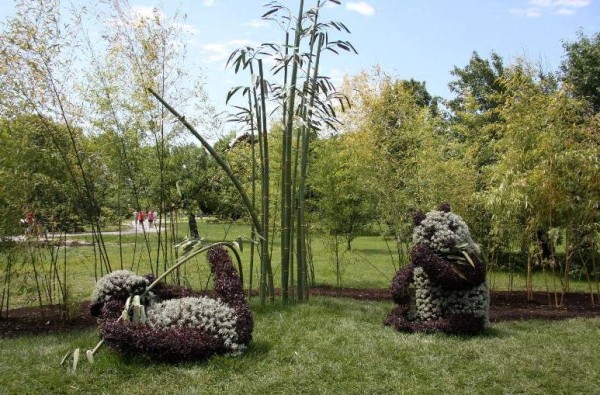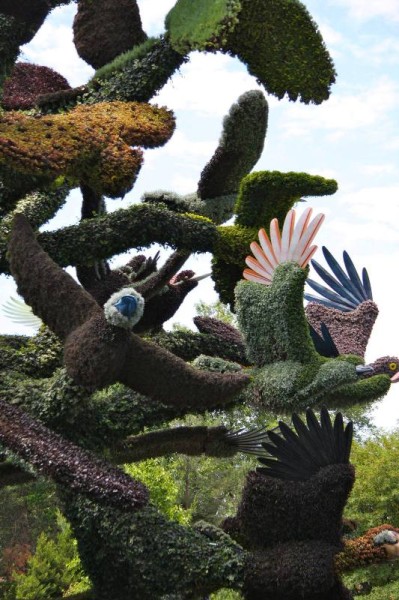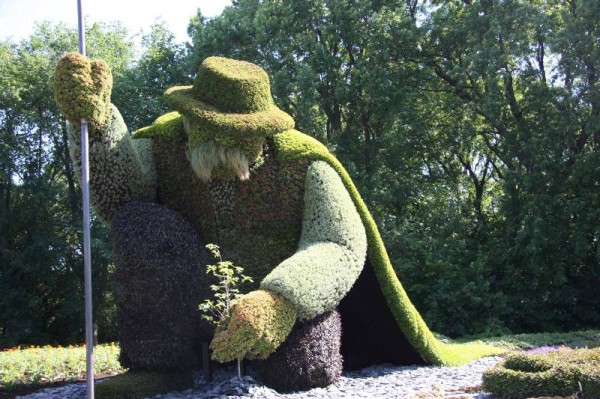WWF brings plant sculpture pandas to Montreal
Today, I was one of the lucky guests at the grand opening of Mosaïcultures Internationales Montréal 2013– Land of Hope, an exhibition of horitcultural sculptures representing biodiveristy at the Montreal Botanical Garden. The exhibit aims to amaze visitors while raising their awareness of the importance of preserving the richness of life on Earth. WWF-Canada supported one of the works on display: two giant pandas crafted by the Canadian team (of course!).
Giant Panda sculptures at Mosaïcultures Internationales Montréal 2013 (C)WWF-Canada/ Marie-Claude Lemieux
The theme, Land of Hope, reflects the mission of both Mosaïcultures Internationales Montréal and WWF. The organizers have integrated sustainable development practices at every level, and this is the largest event ever to receive green certification from the City of Montreal. This certification meets the environmental requirements of the Bureau de normalisation du Québec. The exhibit will display the creations of artists from more than 20 countries in addition to those representing several Canadian cities.
As visitors will see, the exhibit explores important environmental themes, including: the threatened species and ecosystems of our planet; the positive interaction possible between humans and their environment; the interdependence between humans and nature; the beauty and fragility of life on the planet; nature in the city; and peace, an essential condition for survival on the planet.
Visitors will be inspired by the messages conveyed by the spectacular and unique works of art, including those created by International Mosaiculture of Montreal that are not part of the competition:
THE BIRD TREE features about fifty of our planet’s threatened species and ecosystems. The Andean condor, the peregrine falcon, the whooping crane, the piping plover, and many others will fly out of the Bird Tree to escape extinction. This 15-meter-high work is inspired by Harvey Locke’s mission to develop a program to protect the natural areas of the world, both on land and in the sea.
The Bird Tree at Mosaïcultures Internationales Montréal 2013 (C)WWF-Canada/ Marie-Claude Lemieux
THE MAN WHO PLANTED TREES illustrates the positive interaction that is possible between man and his environment and the resulting message of hope for the future of our planet. Frédéric Back collaborated in the creation of this work, which was awarded the Grand Honorary Award by the international jury and the People’s Choice Award at the competition held in Hamamatsu, Japan in 2009. Designed as a real mosaiculture garden, it depicts an arid and desolate place being transformed into a rural landscape, and symbolizes the return of life.
The Man Who Planted Trees at Mosaïcultures Internationales Montréal 2013 (C)WWF-Canada/ Marie-Claude Lemieux
MOTHER EARTH represents the interdependence between humans and nature. It’s a work based on North-American aboriginal culture and its creation was inspired by the Declaration of Interdependence written in 1992 by David Suzuki during the Rio de Janeiro Earth Summit. Known also as Terre mere, Pachamama, Terra Mater or Mahimata, this universal symbol transcends time and borders.
Mother Earth at Mosaïcultures Internationales Montréal 2013 (C)WWF-Canada/ Marie-Claude Lemieux
For those who have a chance to visit, the experience will be magical – and an important reminder of why we need to work to live in harmony with nature.





